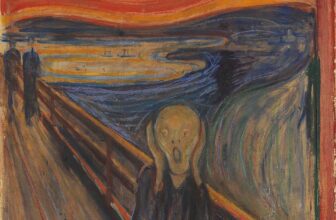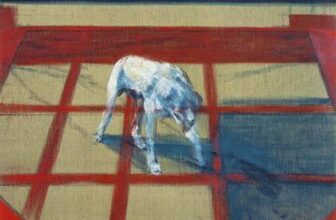
The Story Behind The Awakening Conscience by William Holman Hunt
Amidst the opulence and strict morality of Victorian England, a painting emerged that rattled social norms and cracked the veneer of respectability. It was not merely a work of beauty, but a moral lesson wrapped in symbols and expressions, a narrative frozen in time. This painting was “The Awakening Conscience”, created by William Holman Hunt, one of the founding members of the Pre-Raphaelite Brotherhood. More than just oil on canvas, it was, and remains, a bold commentary on morality, redemption, and inner transformation.
Let us step into this world, not only to admire the brushstrokes but to feel the emotional tremor of that singular moment captured in Hunt’s masterpiece.
The Painter: William Holman Hunt
To understand “The Awakening Conscience,” we must first know the hand that painted it.
William Holman Hunt (1827–1910) was a British painter, deeply committed to realism, truth in art, and moral storytelling. Along with Dante Gabriel Rossetti and John Everett Millais, he co-founded the Pre-Raphaelite Brotherhood in 1848. They rejected the academic art standards of their time, seeking inspiration instead from the art before Raphael, art that was rich in detail, vibrant in color, and earnest in meaning.
Hunt’s works often intertwined religion, morality, and symbolism. He wasn’t interested in painting pretty pictures, he wanted to change hearts and open eyes. And nowhere is this more evident than in “The Awakening Conscience.”
What the Painting Shows
“The Awakening Conscience” was painted in 1853–1854 and is an oil on canvas measuring approximately 76.2 × 55.9 cm (30 × 22 inches). On first glance, it shows a man and a woman in a well-furnished Victorian drawing room. The man, seated at a piano, plays a tune while the young woman rises suddenly from his lap, her eyes gazing into the distance with an expression that is both startled and illuminated.
The woman is not dressed in the fashion of a proper Victorian wife, nor does her body language suggest joy or romance. Instead, she is caught in a fleeting moment of revelation. The sunlight filters through the window, lighting up her face and suggesting a divine or spiritual awakening.
The Meaning of “The Awakening Conscience”
This is not just a home scene, it is a spiritual drama. The painting captures a moment when a “kept woman” experiences a sudden realization about the immoral life she is leading. She is a mistress, possibly lured or seduced into her current lifestyle, and this moment marks her moral awakening, a spark of conscience that urges her to seek redemption.
The man, completely absorbed in his music, is oblivious to her transformation. This contrast between inner revelation and outer ignorance is central to the painting’s impact.
Hunt intended this painting to be a moral allegory, a visual sermon. At a time when women in such positions were seen as fallen and beyond saving, Hunt boldly suggested that redemption was still possible, that conscience could still stir even in the darkest of situations.
Symbolism: A Room Full of Messages
Hunt didn’t rely on dramatic gestures or overt religious symbols. Instead, he packed the room with symbolic details that quietly reinforce the painting’s message.
The Woman’s Ringless Hand: She wears no wedding ring, a subtle but powerful indication that she is not married to the man she’s with.
The Glove on the Floor: One glove lies discarded on the floor, a common Victorian symbol of lost virtue or sexual impropriety.
The Mirror: Behind the woman is a mirror reflecting a bright garden. This serves as a metaphor for the life she might return to, a purer, free, and natural existence outside the “gilded cage” of this room.
The Cat with the Bird: A cat playing with a dead bird, partially hidden in the shadows, subtly mirrors the woman’s own situation, trapped, possibly destroyed, for male amusement.
The Music Sheet: The music played is “Oft in the Stilly Night,” a nostalgic song about lost innocence and regret. It triggers her awakening and underscores the theme of remembrance and repentance.
The Furniture: The room is furnished elaborately but tastelessly, gaudy and excessive, like the life of sin she now questions. Hunt was known to rent a real apartment to paint this room from life, ensuring every detail was realistic.
A Moral Painting in a Sensual Age
The painting was controversial in its time, not because of nudity or violence, but because of its subject. Victorian society preferred its art to reinforce its values, not challenge them. Yet Hunt did both.
He painted a woman who was not a villain, but a victim, and gave her an inner life and capacity for redemption. This ran counter to the common trope of the “fallen woman” who was irredeemable. Here was a message that virtue could return, even in compromised circumstances.
Critics were divided. Some praised its depth and originality. Others found it troubling. But it was impossible to ignore.
What Type of Art Is “The Awakening Conscience”?
This painting belongs to the Pre-Raphaelite movement, which combined:
Realism: Meticulous attention to detail, inspired by nature and medieval art.
Symbolism: Objects and settings carry layered meanings.
Moral storytelling: Strong narratives often tied to spiritual or ethical issues.
Technically, it is an example of genre painting, art that depicts scenes from everyday life. However, in the hands of Hunt, genre becomes something deeper: a moral parable rendered with almost photographic precision.
Its blend of realism and symbolism, along with its strong narrative element, also places it within the tradition of Victorian moral art.
The Theme of the Painting: Conscience, Redemption, and Inner Awakening
At its core, the painting explores a universal theme: the human capacity for change. The woman’s physical posture, rising, half-standing, mirrors her internal transition from complacency to moral consciousness.
The theme can be broken into three components:
Conscience – The sudden awareness of wrongdoing or loss of self.
Awakening – A moment of clarity that disrupts the status quo.
Redemption – The possibility of a new path, of reclaiming lost virtue.
Importantly, the painting doesn’t show what happens next. It freezes the moment before the decision. This ambiguity is intentional. The viewer is invited to hope, to imagine, and perhaps to reflect on their own moments of awakening.
The Model and the Muse: Real-Life Inspirations
The model for the woman was Annie Miller, a working-class girl whom Hunt attempted to “rescue” from poverty and educate in the arts. Their relationship was complex, part romantic, part moral crusade.
Some critics argue that Hunt was projecting his own fantasies of saving women like Annie onto the canvas. Regardless, the emotional sincerity of the painting is undeniable.
The man, anonymous in his role, is thought to represent a type, wealthy, powerful, and oblivious to the woman’s humanity.
Current Location: Where Is the Painting Today?
Today, “The Awakening Conscience” resides in the Tate Britain gallery in London, one of the UK’s most prestigious art institutions. It remains one of the highlights of their Pre-Raphaelite collection.
Visitors to the Tate can stand before it, just as the Victorian public once did, and perhaps find themselves similarly stirred. The painting has lost none of its emotional power.
Legacy and Influence
“The Awakening Conscience” helped pave the way for a more nuanced portrayal of women in art. It stood against the grain of its time, suggesting that moral agency was not exclusive to men, and that women, even those considered “fallen”, could have complex inner lives.
Later Victorian literature, such as the novels of Thomas Hardy and George Eliot, would also explore themes of female agency, redemption, and societal judgment. Hunt’s painting was part of that broader cultural shift.
The work also influenced future artists who sought to imbue everyday scenes with deeper significance, and it remains a touchstone in studies of feminism in Victorian art.
Closing Thoughts: A Mirror for the Soul
“The Awakening Conscience” is more than an image, it’s an invitation. It asks each viewer: Have you had such a moment? A jolt of recognition, a whisper of conscience, a stirring that challenges the life you’ve accepted?
William Holman Hunt didn’t just paint a woman in a room. He painted the instant a soul begins to rise. It is, in essence, a celebration of our moral potential, the idea that no matter how far one has wandered, there is always a path back into the light.
In an era defined by rigid morality and social hypocrisy, “The Awakening Conscience” dares to believe in grace.




